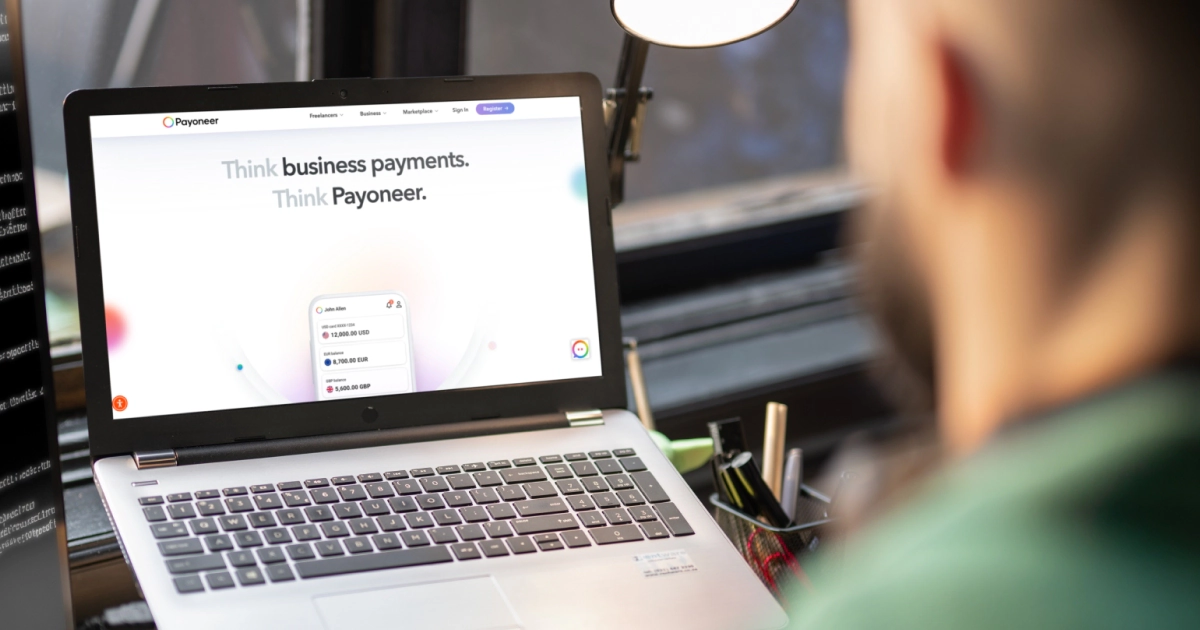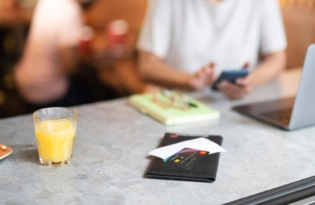What is an IBAN Number: A Complete Guide
IBANs make international payments safer and more accurate. This guide explains what an IBAN is, how it works, how it differs from SWIFT, and how services like Payoneer help you access virtual IBANs for smooth global transfers.

If you’ve ever sent or received money internationally, you may have come across the term IBAN—International Bank Account Number. An IBAN is a standardized system for identifying bank accounts across borders, ensuring payments are processed accurately and efficiently.
Originally developed by the European Committee for Banking Standards, IBANs are now used in over 70 countries worldwide. They help reduce errors in international transactions by providing a structured format that includes key banking details, such as a country code, check digits, and account number.
For businesses, freelancers, and individuals making global payments, understanding how IBANs work is very important. Whether you’re sending money to an overseas supplier or receiving payments from international clients, an IBAN simplifies the process and minimizes the risk of payment failures.
In this guide, we’ll break down what an IBAN is, how it works, and why it’s crucial for hassle-free cross-border transactions. We’ll also explore how Payoneer provides a virtual IBAN to help businesses and freelancers get paid globally with ease.
How an IBAN works
An IBAN is not so much a bank account number as it is a unique identifier that helps banks and financial institutions locate the correct account when processing international payments.
While IBAN formats vary by country, they all follow a standardized structure. This includes:
- Country Code —A two-letter code representing the country (e.g., GB for the United Kingdom, DE for Germany and so forth)
- Check Digits—Two verification digits that help detect errors in the IBAN
- Bank Identifier—A set of numbers identifying the specific bank
- Account Number—The actual bank account number, unique to the account holder
For example, an IBAN for the UK might look like this: GB29 NWBK 6016 1331 9268 19
- GB → Country Code (United Kingdom)
- 29 → Check Digits
- NWBK → Bank Code (NatWest Bank)
- 60161331926819 → Account Number
How an IBAN ensures secure and accurate transfers
Before IBANs were introduced, international transactions were prone to errors due to inconsistent account number formats across different countries.
The IBAN system solves this problem by:
- Standardizing account numbers to prevent incorrect payments.
- Allowing banks to validate details before processing a transaction.
- Reducing transfer delays caused by missing or incorrect information.
IBAN vs. SWIFT/BIC Codes
IBANs and SWIFT/BIC codes are often mentioned together, but they serve different purposes:
| Feature | IBAN | SWIFT/BIC Code |
| Purpose | Identifies a specific bank account | Identifies a specific bank institution |
| Used for | Receiving payments | Routing payments between banks |
| Format | Country code + digits | 8-to-11-character alphanumeric code |
In short, an IBAN ensures that money reaches the correct account, while a SWIFT/BIC code directs the payment to the right bank.
Why IBANs are important for international payments
For anyone making or receiving payments across borders, an IBAN is critical to ensure money is transferred quickly and correctly. Without it, international transactions can be delayed, rejected, or even sent to the wrong recipient.
An IBAN simplifies and secures global payments by:
- Reducing errors: The standardized format and built-in check digits help banks validate the account before processing the payment.
- Preventing failed transactions: Without an IBAN, payments may be rejected or misrouted, leading to unnecessary fees and delays.
- Ensuring faster transfers: Banks can process IBAN-based payments more efficiently, reducing the time it takes for funds to arrive.
- Improving transparency: The IBAN provides clear details about the recipient’s bank, minimizing confusion in international banking.
Which countries use IBAN?
Not all countries use IBANs, but over 70 have adopted the system, primarily in Europe, the Middle East, and parts of Africa. Countries like the UK, Germany, France, Spain, Italy, and the UAE require IBANs for all international transactions.
However, major economies such as the United States, Canada, Australia, and China do not use IBANs. Instead, they rely on routing numbers and SWIFT codes for international payments. If you’re sending money to a country that doesn’t use IBANs, you may need additional details, such as the bank’s SWIFT/BIC code and the recipient’s account number.

How to find or generate your IBAN
If you need to send or receive an international payment, knowing your IBAN is essential. Fortunately, finding your IBAN is simple, and there are multiple ways to do so.
Most banks provide IBANs automatically for international transactions. You can check yours by:
- Bank statements: Many banks print IBANs directly on monthly statements.
- Online banking: Log into your online banking portal—most banks display the IBAN alongside your regular account details.
- IBAN calculator tools: Some banks and financial institutions offer IBAN. calculators where you enter your account details to generate an IBAN.
- Customer support: If you’re unsure, contact your bank’s customer service to request your IBAN.
Avoiding payment delays with IBANs
Using an incorrect or incomplete IBAN can result in:
- Payment rejections by the recipient’s bank.
- Extra fees due to failed or misrouted transfers.
- Longer processing times, as banks may require manual intervention to correct errors.
To avoid these issues, always double-check the IBAN before initiating a transfer, either by verifying it with the recipient or using an IBAN validation tool provided by banks.
Generating an IBAN for business or freelance payments
If you’re a freelancer or business owner who frequently deals with international clients, having an IBAN is crucial. Here’s how to get one:
- Open a bank account in an IBAN-using country (e.g. a European business account).
- Use a payment provider like Payoneer, which offers virtual IBANs for receiving payments globally.
- Verify your IBAN using your bank’s online platform or an IBAN validation tool before sharing it with client.
Using a Payoneer IBAN for global transactions
For freelancers, eCommerce sellers, and businesses operating internationally, receiving payments from global clients can be a challenge. Especially if traditional banking systems impose high fees and slow processing times. This is where Payoneer’s IBAN feature makes a difference.
A Payoneer IBAN is a virtual bank account number that allows you to receive international payments just like a local bank account in multiple currencies. Instead of opening multiple bank accounts worldwide, you can use your Payoneer IBAN to get paid by global clients, marketplaces, and companies without excessive fees or delays.
How it works
When you sign up for Payoneer, you gain access to local receiving accounts in different currencies, including USD, EUR, GBP, and more. Each of these accounts comes with an IBAN or equivalent banking details, allowing you to:
- Receive bank transfers from international clients as if you had a local bank account in their country.
- Withdraw funds to your local bank account in your preferred currency.
- Use your Payoneer balance to make payments, purchase online, or withdraw via an ATM.
Benefits of using Payoneer for international payments
Payoneer simplifies global transactions by offering:
- Multiple Currency IBANs—Receive payments in USD, EUR, GBP, JPY, CAD, AUD, and more without currency conversion fees.
- Lower Fees Than Traditional Banks—Avoid hefty wire transfer costs and unfavorable exchange rates.
- Faster Payment Processing—Get paid quicker than through traditional international bank transfers.
- Seamless Integration with Marketplaces—Accept payments from platforms like Amazon, Fiverr, and eBay directly into your Payoneer account.
- Global Reach Without a Local Bank Account—No need to have bank accounts in multiple countries, Payoneer does it for you
How to get a Payoneer IBAN
By using Payoneer’s IBAN feature, businesses and freelancers can eliminate banking barriers, reduce fees, and speed up international transactions, making it one of the best solutions for receiving global payments.
Follow these steps to get one:
1. Sign up for a Payoneer account if you don’t already have one.
2. Complete your account verification (ID and business details may be required).
3. Go to the “Global Payment Service” section in your Payoneer dashboard.
4. Select the currency you need (e.g. USD, EUR) and retrieve your IBAN and banking details.
5. Share your Payoneer IBAN with clients, marketplaces, or companies to receive payments.
Frequently asked questions (FAQs)
1. What is an IBAN?
An IBAN (International Bank Account Number) is a standardized and unique form of identification for bank accounts globally, made of up to 34 alphanumerical characters. It is structured by four components: country code, check digits, bank identifier and account number. IBANs ensure accurate international payments, reduce errors, and speed up processing.
2. How is an IBAN different from a bank account number?
An IBAN includes your bank account number but also contains a country code, check digits, and bank identifier, making it unique and suitable for international transfers.
3. Which countries use IBAN?
Over 70 countries use IBANs, including those in Europe, the Middle East, and parts of Africa. The U.S., Canada, Australia, and China do not use IBANs but rely on other systems like SWIFT codes.
4. How do I find my IBAN?
You can find your IBAN on bank statements, online banking portals, IBAN calculators, or by contacting your bank directly.
5. Can I generate an IBAN online?
No, IBANs are assigned by banks. However, some banks provide IBAN calculators that let you derive the IBAN based on your existing account details.
6. What happens if I use the wrong IBAN?
A wrong IBAN may lead to a failed transaction, delays, or funds being sent to the wrong account. Always verify IBAN details before making a transfer.
7. Is it safe to share my IBAN?
Yes, an IBAN alone cannot be used to withdraw money from your account. However, avoid sharing it publicly to prevent fraud risks like phishing scams.
8. Can I use an IBAN without a SWIFT code?
An IBAN identifies a specific account, while a SWIFT/BIC code identifies the bank. Many international transfers require both to ensure proper routing.
Related resources
Latest articles
-
Optimizing your financial website for AI-powered search algorithms
SWIFT connects 11,000+ banks worldwide, powering secure international transfers. This guide explains how SWIFT works, why it’s still widely used, how to find your SWIFT code, and how Payoneer helps you receive global payments efficiently.
-
How to hire employees in Ireland
Looking to hire employees in Ireland for your US company? Learn about employment in Ireland and how Payoneer Workforce Management makes it easy to hire in Ireland.
-
Planning to hire employees in Indonesia? Here’s a quick guide
Are you looking to hire employees in Indonesia? Learn about hiring in Indonesia and how Payoneer Workforce Management can help American companies hiring in Indonesia.
-
Planning to hire employees in France? Here’s a quick guide
Looking to hire employees in France for your U.S. company? Learn about employment in France and how Payoneer Workforce Management makes it simple to hire in France.
-
Planning to hire employees in Spain? Here’s a quick guide
Are you looking to hire employees in Spain? Learn about employment in Spain and how Payoneer Workforce Management can help American companies hiring in Spain.
-
How to hire employees in the Netherlands
Looking to hire employees in the Netherlands for your U.S. company? Learn about employment in the Netherlands and how Payoneer Workforce Management can help hire in the Netherlands.
Disclaimer
The information in this article/on this page is intended for marketing and informational purposes only and does not constitute legal, financial, tax, or professional advice in any context. Payoneer and Payoneer Workforce Management are not liable for the accuracy, completeness or reliability of the information provided herein. Any opinions expressed are those of the individual author and may not reflect the views of Payoneer or Payoneer Workforce Management. All representations and warranties regarding the information presented are disclaimed. The information in this article/on this page reflects the details available at the time of publication. For the most up-to-date information, please consult a Payoneer and/or Payoneer Workforce Management representative or account executive.
Availability of cards and other products is subject to customer’s eligibility. Not all products are available in all jurisdictions in the same manner. Nothing herein should be understood as solicitation outside the jurisdiction where Payoneer Inc. or its affiliates is licensed to engage in payment services, unless permitted by applicable laws. Depending on or your eligibility, you may be offered the Corporate Purchasing Mastercard, issued by First Century Bank, N.A., under a license by Mastercard® and provided to you by Payoneer Inc., or the Payoneer Business Premium Debit Mastercard®, issued and provided from Ireland by Payoneer Europe Limited under a license by Mastercard®.
Skuad Pte Limited (a Payoneer group company) and its affiliates & subsidiaries provide EoR, AoR, and contractor management services.










